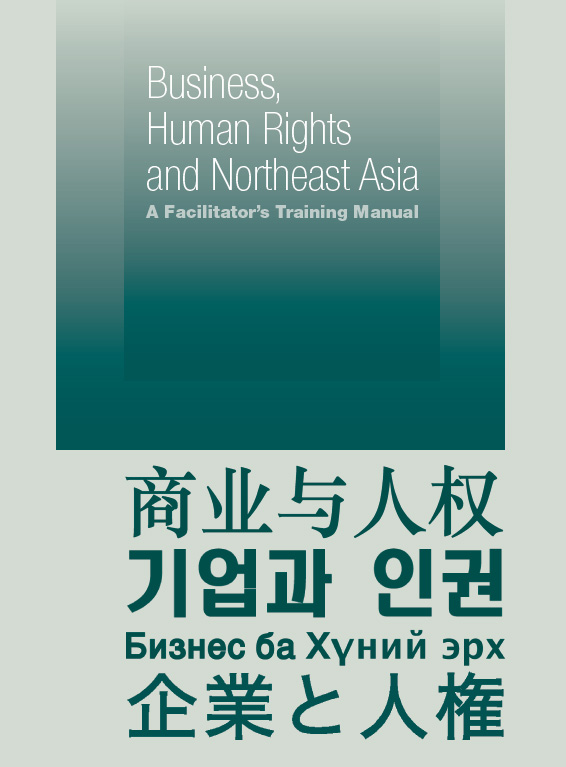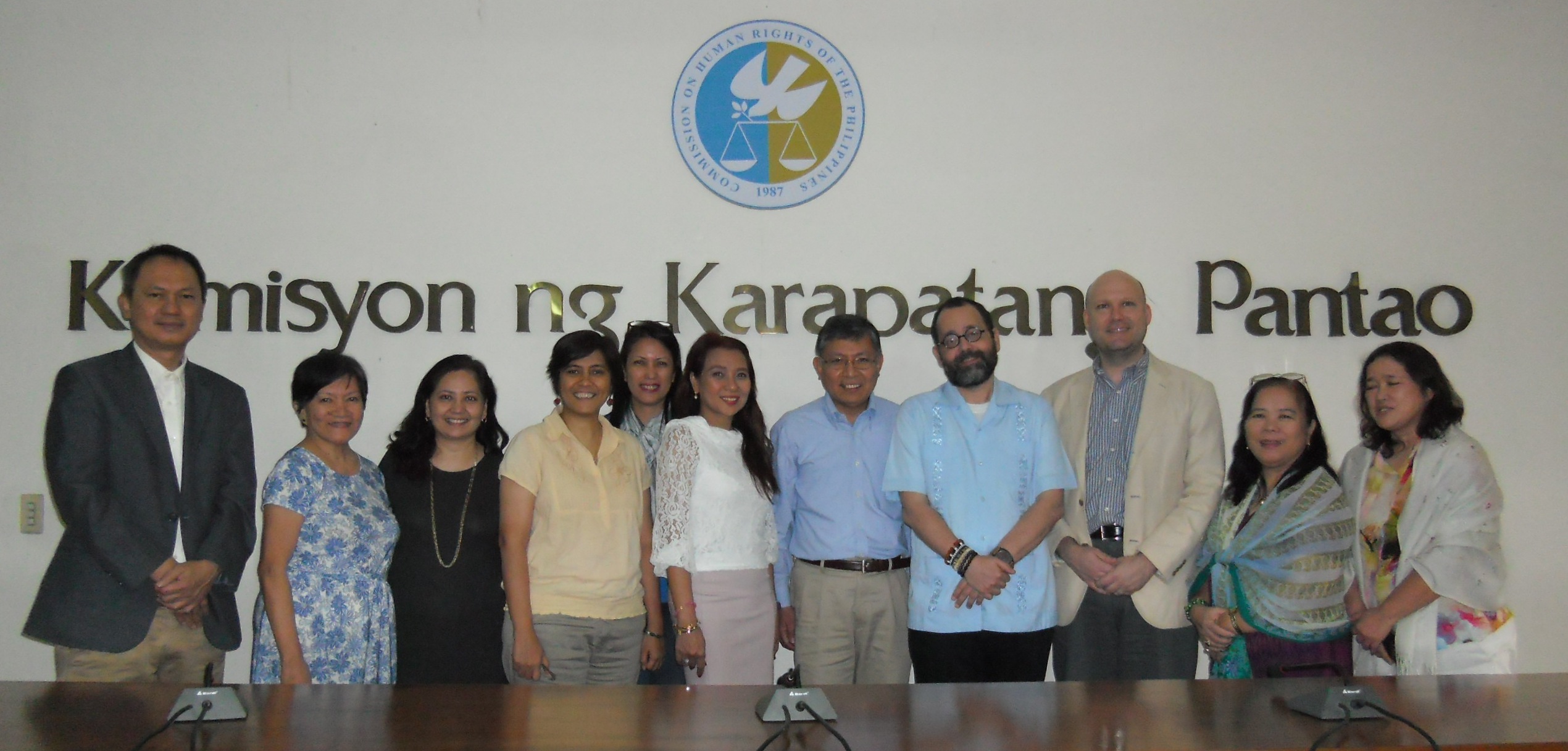- TOP
- 資料館
- FOCUS
- March 2016 - Volume 83
- A Facilitator's Training Manual on Business and Human Rights
FOCUS March 2016 Volume 83
A Facilitator's Training Manual on Business and Human Rights
Interest on the issue of “business and human rights” has been rising in recent years among governments, national human rights institutions, academics, consultancy firms and non-governmental organizations in Asia. Some four hundred representatives of many of these institutions are expected to gather for the first ever United Nations Asian regional workshop on this issue on 19-20 April 2016 in Doha. 1
Alongside the development of guiding principles on business and human rights by the United Nations, many other initiatives have been launched that focus on specific areas of this issue. They constitute the international frameworks for companies on respecting and protecting human rights.
In Southeast Asia, several inter-governmental and non-governmental initiatives have been launched that range from research to advocacy activities. In Northeast Asia, national initiatives have been undertaken in South Korea and Mongolia by their non-governmental organizations and National Human Rights Commissions; in Japan a number of consultancy firms (local and international) have been actively working on this issue with Japanese companies under the corporate social responsibility framework. Many Northeast Asian companies have also become members of the United Nations Global Compact.
Business, Human Rights and Northeast Asia
The Northeast Asian members of the Asian Consortium for Human Rights-based Access to Justice (HRBA2J-Asia) followed up its research on Northeast Asian companies (published in 2014 as Bridging Human Rights Principles and Business Realities in Northeast Asia) with the development of a training manual on business and human rights.
The training manual draws much of its content from the research publication on Northeast Asian companies. Many of the cases discussed in the reports from China, Japan, Korea and Mongolia have been transformed into materials for workshop activities such as case studies. Other sections of the research publication have been cited as reference materials for the training modules.
Materials from the International Labour Organization (ILO), United Nations Development Programme and other United Nations agencies have been used as sources of definitions of terms and concepts related to business and human rights, the guiding principles on business and human rights, and the mechanisms for accessing remedies.
As additional sources, materials produced by research institutions and non-governmental organizations also provided concrete examples of grievance resolution through different forms of mechanisms. Much of the examples emphasize the role of the affected people (workers and members of communities) in order to illustrate how human rights-based approach to access to justice can be employed in practice.

Review of Draft Training Manual
The draft of the training manual was reviewed in a meeting held in the Commission on Human Rights of the Philippines (CHRP) on 30 January 2016. People who were involved in education work on the business and human rights issue participated in the review of the draft training manual. The review meeting was organized through the secretariat of the HRBA2J-Asia and with the support of the CHRP. The review raised a number of significant suggestions on the content of the draft training manual. The idea of putting the section on the definition of concept and terms related to business and human rights at the beginning instead of having it as the last section of the training manual was one of the suggestions raised. There were also suggestions on adding more instructions in the training modules to enable the facilitators using the training manual have a better grasp of the learning process being employed. The review meeting likewise affirmed the importance of having annexes in the training modules that the trainees/participants, facilitators and resource persons can all refer to during the training. These annexes cover concrete cases as materials for the group discussion, brief explanation on different components of the business and human rights principles, the grievance mechanisms, and short description of experiences on using these grievance mechanisms.
Training Manual
The training manual was completed in March 2016 with the title Business, Human Rights and Northeast Asia - A Facilitator’s Training Manual.2 This training manual focuses on facilitating learning on human rights principles, companies and their relations to access to remedy, the third pillar of the United Nations Guiding Principles on Business and Human Rights.3
The “access to remedy” emphasis of the training manual logically defined its content. Most of the modules of the training manual are on different forms of mechanisms that facilitate access to remedy. The training manual has the following training modules:
• Context of the Northeast Asian Subregion
- Human Rights Issues and Business;
• Context of the Northeast Asian Subregion
- National Development Policies and Business;
• Implementing United Nations Initiatives - UN “Protect, Respect and Remedy” Framework, UN Global Compact;
• Enforcing Labor Standards;
• Using International Corporate Standards and Frameworks;
• Principles of Human Rights-based Approach to Access to Justice;
• Corporate Mechanisms and Access to Justice;
• Administrative and Judicial Mechanisms and the UN Framework; and
• Resorting to Mechanisms of International Institutions.
To help facilitators and resource persons use the training manual effectively, there is a section on definition of concepts and terms related to the business and human rights issue; while each training manual has annexes and reference texts that provide relevant information, concrete cases and discussion on concepts involved. The training modules employ adult participatory learning methods that value the input of the trainees/participants in the whole learning process.
Need for Training Manual
Due the significantly high level of interest on the business and human rights issue at the international level, a number of materials (books, reports, training manuals) have been produced by different institutions. And yet there remains the question: how many of the communities adversely affected by business operations have been informed about the new international framework on business and human rights that may provide opportunities for them to address their own problems?
The training manual is designed to respond to this question with its core message of making remedies to grievances accessible to those involved in (workers) or affected by (surrounding communities) business operations. Additionally, the training manual stresses the importance of learning from existing access to justice experiences in Northeast Asia that demonstrate how this third pillar of the United Nations Guiding Principles on Business and Human Rights could be within the reach of the affected people. This training manual is thus a contextualized learning material on international human rights standards.
It is meant to be used by members of civil society organizations whose work relate in one way or another to issues arising from company operations.
Although the training manual is contextualized in Northeast Asia and targets the members of civil society organizations it is nevertheless adaptable in at least two senses:
a. The context of issues can be changed from that of Northeast Asia to that of another subregion in Asia. Corresponding information on experiences and practices can be changed to those of a different subregional context without affecting the contents of the training manual on concepts, principles and standards related to business and human rights;
b. The focus of the training manual can also be shifted to managers of business enterprises. In this sense, other relevant experiences and practices can be used to suit these types of trainees/participants.

For further information, please contact HURIGHTS OSAKA.
Endnotes
1 Bridging Human Rights Principles and Business Realities in Northeast Asia (HURIGHTS OSAKA/SIRD, 2014).
2 HURIGHTS OSAKA’s work in the business and human rights issue started with a suggestion by a member of its Board of Councilors (Mr Kenzo Tomonaga) in 2010 for the development of an Asia-Pacific training manual on business and human rights.
3 Guiding Principles on Business and Human Rights for implementing the UN “Protect, Respect and Remedy” Framework. Full text of the document available at www.ohchr.org/Documents/Publications/GuidingPrinciplesBusinessHR_EN.pdf, page 1.
